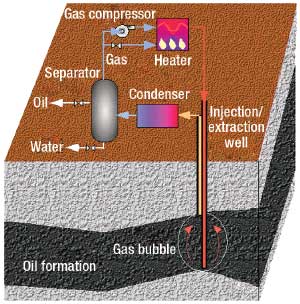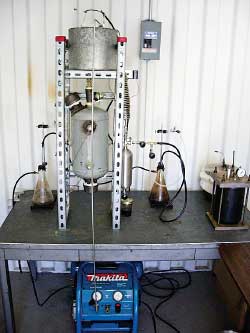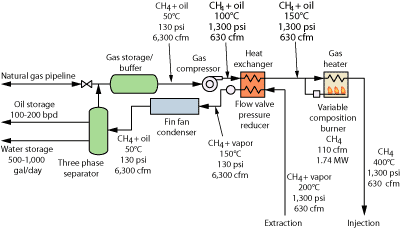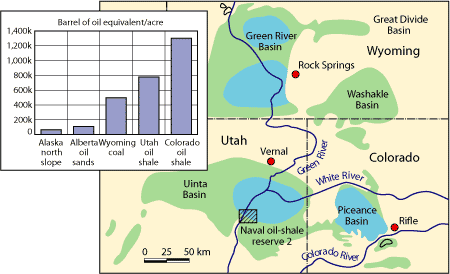An innovative solution to extracting nearly 100% of oil from conventional resources and oil shale is being proposed for development and testing. The in-situ vapor extraction method could solve the technical barriers surrounding other EOR and oil shale retorting techniques.
Kevin Shurtleff, Mountain West Energy; Dave Doyle, Rocky Mountain Oilfield Testing Center
Mountain West Energy (MWE) is proposing to research, develop and demonstrate In-situ Vapor Extraction (IVE) to solve the technical barriers with Enhanced Oil Recovery (EOR) and oil shale retorting. MWE has partnered with the Rocky Mountain Oilfield Testing Center (RMOTC) to demonstrate IVE for EOR on a well at Teapot Dome oil field near Casper, Wyoming. The project is slated to begin this spring.
IVE is a production process that accelerates traditional production methods by initiating chemical processes to vaporize crude oil underground. Single-well, single-phase gas extraction as proposed by MWE is absolutely new to the oil industry. IVE for EOR has the potential to increase the extraction efficiency from some oil reservoirs to more than 80% of the original oil in place. IVE can improve oil recovery from conventional oil resources and make oil conversion and extraction from the vast oil shale resources technically and economically feasible.
More than 40% of the total energy consumed in the US in 2005 came from oil. However, 66% of the oil consumed in the US in 2005 was imported. Domestic oil production peaked in 1971 due in part to the fact that oil production technology has not advanced beyond finding and extracting the oil nature has already produced.
PROPOSED IVE PROCESS FOR OIL SHALE
The ultimate target for the IVE process is the vast domestic oil shale resources in the western US. A simplified schematic of MWE’s IVE process for oil shale is shown in Fig. 1. A single well is drilled into the target oil shale layer using conventional techniques and the well is cased, cemented and perforated. The surrounding shale is fractured to increase its permeability. A string of specialized production tubing is inserted down the center of the well to inject hot natural gas into the bottom of the shale layer. As the gas flows up through the shale, it forms a high-pressure, high-temperature gas bubble that heats the shale by convection to the pyrolysis temperature and reduces water intrusion. This breaks down the kerogen in the shale, forming oil and gas.
 |
|
Fig. 1. Simplified schematic of the In-situ Vapor Extraction (IVE) process.
|
|
Oil, gas and water vapors are swept to the top of the shale layer where they flow to the surface through the annulus between the casing and the tubing. Packers between the casing and tubing isolate gas injection at the bottom of the well from gas extraction at the top of the well. The oil and water vapors are condensed back into liquids and separated from the gas at the surface. The gas is re-compressed, re-heated and re-injected into the oil shale layer to repeat the extraction process.
TECHNICAL TARGETS
MWE has established the following technical targets in the development of the IVE process:
- Measure the improvement in API gravity of oil extracted from oil shale as a function of IVE parameters (gas flow rate, temperature, pressure and composition) in a laboratory-scale system
- Determine the solubility and mobility of natural gas in oil shale as a function of pressure and temperature in conjunction with the Petroleum Research Center (PERC) at the University of Utah
- Measure the mechanical properties of oil shale from the Green River Formation, Parachute Creek member, Mahogany zone and prepare a fracturing plan
- Create a computer model of the oil shale and simulate the single-well, IVE process in conjunction with PERC
- Design, build and test the surface equipment for IVE
- Partner with RMOTC to demonstrate IVE for EOR on a well in the Shannon formation of Teapot Dome oil field, operated by the US Department of Energy (DOE)
- Demonstrate IVE in the field for producing oil from oil shale.
LABORATORY-SCALE IVE SYSTEM
The laboratory-scale IVE system has been used to extract oil from oil shale samples obtained from the Utah Geological Survey Core Research Center, Fig. 2. A standard compressor, shown at the bottom of the figure, compresses natural gas to approximately 100 psig. The gas flows through a coil inside the electric heater at the top of the system, where it is heated to approximately 450°C. The high-pressure, high-temperature gas is injected at the bottom of the reaction chamber, which is filled with pieces of oil shale. The gas flows up through the oil shale and exits at the top of the chamber where it passes through a condensing coil. The condensed oil is deposited in the stainless steel cylinder on the side of the chamber. The gas passes through a control valve and two additional ice water condensers before being re-circulated back to the compressor intake, completing a closed-loop.
 |
|
Fig. 2. Laboratory-scale IVE system.
|
|
MWE’s preliminary test results indicate that the API gravity of the oil changes depending upon the temperature and the flow rate of the injected natural gas (i.e. the oil shale heating rate). A slower heating rate tends to produce higher API oil. To date, the highest quality oil to be produced was over a two hour extraction period, which resulted in an API of about 21. The target API gravity of oil extracted with IVE is 30. A lower API gravity was targeted in order to increase the extraction rate and thus improve the economic feasibility of the project. Additional laboratory experiments are required to determine the optimum extraction parameters to achieve the target gravity oil prior to demonstration of the IVE process for oil shale.
DEMONSTRATING THE IVE PROCESS FOR EOR
With the equipment designed, built and tested, the next step is to demonstrate the IVE process for EOR. Teapot Dome oil field, which is operated by RMOTC under the DOE, will serve as the demonstration site. Testing will be conducted in phases and be dependent upon results achieved. The data collected from the testing of the IVE process for EOR will be critical in designing the demonstration of the IVE process for oil shale. The goals for the initial phase of testing are to demonstrate:
- Production of downhole flow geometry that will provide vertical and horizontal sweep of the predicted area
- That instrumentation and data acquisition processes are correct for the task
- That the equipment can be operated safely
- That a portion of the lab tests can be validated by observing a modest increase in oil production resulting from lowering the viscosity of the Shannon oil. This results from absorption of the extra natural gas into the crude oil.
Teapot Dome has more than 450 producing wells in the Shannon formation. This oil-producing formation is relatively shallow (250-1,100 ft) and is estimated to contain 143 million barrels of oil. However, only 11.5 million barrels have been extracted, far less than anticipated. Oil has primarily been recovered by gravity drainage and solution gas drive (i.e., natural gas injection). Some parts of the formation have been produced with steam flood and natural gas “huff and puff.” All of the primary, secondary and EOR techniques applied to the Shannon formation have focused on liquid-phase and multi-phase extraction. Gas-phase extraction could prove to be very efficient in this formation.
IVE has important advantages for EOR from conventional oil reservoirs. For example, IVE solves the low viscosity issues observed with other EOR techniques by converting the oil from a liquid into a gas. Reservoir mobility is significantly higher for gases than for liquids. Consequently, gas flow rates and thus oil production rates will be significantly higher with IVE. In conventional oil recovery, capillary forces between the liquid oil and the formation rock prevent most of the liquid oil from escaping the reservoir. With IVE, much smaller capillary forces may enable more oil to be recovered, with the extraction efficiency of IVE theoretically approaching 100% of the original oil in place. Successful development of IVE technology could more than double the known domestic oil reserves beyond what is extractable by current EOR techniques.
The Shannon formation at Teapot Dome oil field has been proposed for several reasons. Thermal EOR recovery is already known. The test well is generally surrounded by previous EOR production, being east of the in-situ combustion area, north of Steam Generator 2 patterns and south of Steam Generator 5 patterns.
The geology of the area is well-known. Production histories have established the presence of sealing faults that isolate the test well area from previous injection. Also, the shallow depth of the Shannon makes the objectives of the first phase tests less expensive.
The paraffinic nature of the Shannon crude oil makes it a good test candidate for the later high temperature phase. The company expects to trigger thermal cracking of the Shannon oil, resulting in a lighter, low paraffin crude oil and free natural gas. While this is not directly the same process as the conversion of oil shale kerogen, the conversion of Shannon oil would demonstrate that the downhole cracking process is, in fact, occurring.
DEMONSTRATING THE IVE PROCESS FOR OIL SHALE
The final part of the proposed project is to demonstrate the IVE process in the field to produce oil from oil shale. The company has obtained oil shale leases on 880 acres of Utah Trust Lands in the Uinta Basin of Utah. The USGS estimates the Mahogany zone (more than 100 ft thick) in the area of the leases contains approximately 180,000 barrels per acre. The company has confirmed this analysis with log data from a well drilled near its leases.
Assuming a single-well IVE process can heat one-half of the oil shale in a 0.72 acre section of the Mahogany zone to a temperature of 350°C in one year, the final part of the project could produce up to 60,000 barrels of oil. However, the company doesn’t anticipate achieving this much oil (50% extraction efficiency) on the first attempt. A major operator’s successful In-situ Conversion Process (ICP) demonstration produced only 1,500 bbl of oil from a 25 ft by 30 ft test plot. The technical target for this part of the project is to produce at least 12,000 bbl of oil from a single well (10% extraction efficiency). Achieving this target in the initial demonstration would validate the IVE process, classify the project as a technical success, and justify the incremental improvements necessary for profitable operation.
FULL-SCALE IVE SYSTEM
A preliminary design for the equipment required for a full-scale IVE system utilizes individual pieces of equipment available from oil and gas suppliers, Fig. 3. However, this equipment has never been integrated as shown. Improved integration technology will advance the oil and gas recovery and processing. For example, heating compressed natural gas to over 400°C has unique challenges. A gas leak may result in a spontaneous fire. Consequently, the system must be designed to safely handle failures, including leak detection and automatic shut-down.
 |
|
Fig. 3. Detailed schematic of IVE equipment.
|
|
Automated collection of process data is required, although this type of data collection is not routine in the oil and gas exploration industry. Another unique piece of equipment in the IVE process is the heat exchanger to transfer heat from the gas stream exiting the well to the injection gas stream. The heat exchanger also could be used to capture heat from gas flowing through a previously depleted well and transferring it to the gas injected into an adjacent producing well. This important piece of equipment will help reduce energy costs for the IVE process. The technical target for this part of the project is to complete a blueprint for the integrated design, specify the components, build the system and test it.
IVE ADVANTAGES
IVE overcomes technical and economic barriers observed with other in-situ retorting processes. Hot gas injection into oil shale to extract oil is not a new technology, as demonstrated by Equity Oil and Chevron. However, using only the gas phase to extract oil vapors is absolutely unique as other extraction technologies typically result in multiple phases (i.e., gas and liquid). IVE’s gas-phase extraction is possible due to the innovative vertical orientation of the extraction point above the injection point. This orientation is required to capture the low density gas as it flows up through the reservoir.
The use of a single well to accomplish this technique is also novel. All other gas injection techniques use two or more wells, separating the injection point horizontally from the extraction point. With IVE, well configuration manages the complex multi-phase environment during oil production better than in other proposed technologies. Utilizing IVE, the number of wells required to extract oil from a 10-acre region of oil shale is 14 (200 feet well spacing). If the well spacing is reduced to 100 feet in order to improve the extraction efficiency, 56 wells are required. As a comparison, one major operator’s ICP requires more than 300 wells to extract oil from a 10-acre plot.
IVE’s retorting techniques possess other benefits. First, convection heating is faster than conductive heating. Pressurized natural gas is an excellent heat transfer medium and the solubility of natural gas in shale is higher than most other gases such as carbon dioxide and nitrogen. Also, while natural gas is not inexpensive, it is readily available in oil shale and other oil producing areas of the US while only a limited amount of CO2 is available in these areas. As hot natural gas absorbs into the shale, it efficiently transfers heat to the shale resulting in faster heating and higher oil production rates.
The natural gas acts to sweep away volatile vapors produced during pyrolysis, leaving the heavier oil components behind for further reaction. If the volatile components are not swept away, they will continue to react, ultimately forming methane. The company expects to control the quality and amount of oil produced to some extent with IVE by controlling the gas flow rate, temperature and pressure. Additionally, some natural gas is produced during pyrolysis of the kerogen, which makes it a superior carrier gas. If another gas was used, such as CO2, it would be contaminated by natural gas, resulting in a low Btu mixture that would have to be separated before it could be reused. If natural gas is used, it can be burned to heat the recirculating gas. Finally, recirculating the natural gas significantly reduces the environmental impact of the process.
TECHNICAL BARRIERS AND RISKS
One of the most important technical barriers to implementing IVE in the field is determining the amount of oil shale that can be heated from a single well. If the IVE process can only heat a small region around each well, it may fail to achieve economic viability. One reason natural gas was selected as the carrier gas for the process is that natural gas is somewhat soluble in shale. High solubility in the oil shale will act to distribute the gas uniformly and extensively around the well. In addition, hot gas absorbed by the shale efficiently deposits heat energy. Fundamentally, the higher the solubility of natural gas in oil shale, the larger the region around each well that can be heated.
For comparison, one operator has proposed injecting hot CO2 into oil shale in an in-situ retorting process similar to standard CO2 flooding of oil reservoirs. However, CO2 is not soluble in the shale, which means the company may not be able to uniformly heat the oil shale between the horizontally separated injection and extraction wells. The technical target for this part of the project is to reliably measure the solubility of natural gas in oil shale as a function of temperature and pressure. The solubility measurements will be performed by PERC.
To enhance the oil production rate of IVE, it may be necessary to artificially fracture the oil shale around the well. State-of-the-art hydraulic fracturing is well understood and practiced for conventional oil and gas wells, however, hydraulic fracturing cannot be implemented until the mechanical properties of the oil shale have been measured. A third-party commercial vendor will be contracted to perform these measurements on oil shale samples from the Utah Geological Survey Core Research Center.
Conventional hydraulic fracturing typically produces a single large fracture along the weakest plane of the rock (bi-wing fracture or butterfly fracture). Although this will likely improve the rate of oil production by IVE, even greater enhancement may be achieved with a more extreme oil shale rubblization technique such as explosive fracturing.
The solubility and mobility data determined for oil shale will be used to create a three-dimensional computer model of the Mahogany zone to simulate the single-well IVE process. The specific technical targets for this part of the project are to calculate the reservoir temperature change and the oil production rate as a function of time for the IVE process. PERC is experienced in developing these types of reservoir models and performing thermal, multi-phase flow calculations for EOR, heavy oil extraction and in-situ oil extraction from oil shale and already has simulated Shell’s ICP and an in-situ combustion process.
A series of seven simulations will be performed according to a central composite design of experiments based on gas temperature, pressure and flow rate. The reservoir temperature profiles will be combined with kerogen pyrolysis kinetics, vapor pressure and flow calculations to predict the oil quality and production rate for the IVE process.
The technical risks related to MWE’s IVE process for EOR and oil extraction from oil shale are as follows:
- A risk that the IVE parameters of gas temperature, pressure and flow rate can’t be optimized to extract good quality oil (about 30 API) at an acceptable rate from a single-well (more than 30 barrels per day)
- A risk that the oil shale is not rich enough in kerogen to justify oil extraction and it contains too much free water to allow the pyrolysis temperature to be reached
- A risk that insufficient solubility and mobility of the kerogen in the oil shale will reduce the region around the IVE well that can be heated to the pyrolysis temperature resulting in poor extraction efficiency and increased costs due to closer spacing of the extraction wells
- A risk that the company will be unable to achieve single-phase oil production with the IVE process as designed or if heat loss problems cannot be overcome
- A risk that energy balance cannot be achieved in utilizing one resource to produce another.
SOURCE OF BENEFITS
Once the proposed IVE technology is successfully demonstrated, it will require the participation of larger oil companies in order to rapidly expand oil production to reach the goal of 1 million bpd within ten years. Consequently, the strategy is to provide non-exclusive licenses for its technology to any domestic oil company interested in oil shale development.
This strategy has a realistic probability of success to decrease US dependence on foreign oil imports from unstable regions of the world. Since more than 94% of the oil shale leases in the Green River formation are located on Bureau of Land Management administered lands in Colorado, Utah and Wyoming, royalty revenue to the Federal government could exceed $6 million per day once the goal of 1 million bpd is achieved (assuming an oil price of $60 per barrel and a 10% royalty).
IMPACT ON INDUSTRY
Successful research, development and demonstration of IVE technology will significantly accelerate the development of the vast domestic oil shale resources in the Green River formation, Fig. 4. One of the conclusions provided in the Strategic Significance of America’s Oil Shale Resources, Vol I, published by the DOE was that an oil shale industry could be established by 2011 and production of 2 million bpd could be achieved by 2020. MWE expects that with its technology, the DOE’s goal of 2 million bpd from oil shale could be accelerated 2-3 years to 2017. The company is confident that its IVE technology will demonstrate profitable oil shale production by the end of 2009, 2-3 years ahead of all other oil shale extraction technologies.
 |
|
Fig. 4. Distribution of oil shale in the Green River formation.
|
|
Each well should produce over 60,000 bbl annually (an average of 160 bpd). By 2011, the company expects to be producing over 16,000 barrels per day at a fully burdened cost of $30 per barrel. At full production, the cost should be less than $20 per barrel, perhaps as low as $15 per barrel depending upon extraction efficiencies. The key is that demonstrating a profitable process will speed the effort to enlist the participation of larger oil companies that can expand production rapidly. 
|
THE AUTHORS
|
|
|
Dr. Kevin Shurtleff holds an MBA from the Marriott School of Management and a PhD in physical chemistry from Brigham Young University. He is the founder, President and CEO of Mountain West Energy, an oil technology company. He was also the founder and President of Trulite Technology and Synexus Energy and a Director and CTO of Trulite, Inc, a publicly traded company. Dr. Shurtleff led development of the Trulite HydroCell hydrogen fuel cartridge and the Synexus Kittyhawk integrated hydrogen fuel cell system. He has directed a number of alternative and unconventional energy projects over the past seven years.
|
|
 |
Dave Doyle is a registered professional engineer with more than 25 years experience in production engineering, production facilities, flow assurance testing and environmental remediation projects. He has worked for Texaco, Cities Service Co (now Oxy USA) and Aqua Technologies. He has been a member of the Society of Petroleum Engineers’ national Technical Committee on Health, Safety and the Environment. He graduated from Penn State University in 1979, majoring in petroleum and natural gas engineering. His graduate work included courses in hazardous waste engineering from South Dakota School of Mines and Technology, and topics in environmental law from the University of Wyoming. He is the author of two professional papers and has been a featured speaker on the subject of oil field and industrial wastewater treatment.
|
|
|








